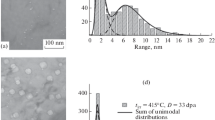Abstract
Swelling at the beginning of the transient stage has been described using point-defect migration theory. The rate of the growth in void diameter at various irradiation temperatures has been calculated for EK-164 steel cladding of the BN-600 reactor. It has been shown that this rate does not depend on the void diameter in a wide temperature range. The characteristics of porosity formed in the steel upon irradiation have been analyzed. The calculated results have been compared with the experimental data obtained for fuel claddings after service in the BN-600 reactor.
Similar content being viewed by others
References
A. V. Kozlov, I. A. Portnykh, A. I. Blokhin, “The dependence of critical diameter of void nuclei in ChS-68 austenitic steel on temperature of neutron irradiation in the model of formation of helium-vacancy bubbles,” Inorg. Mater. Appl. Res. 4, 183–188 (2012).
A. V. Kozlov and I. A. Portnykh, “Migration and accumulation at dislocations of transmutation heliumin austenitic steels upon neutron irradiation,” Phys. Met. Metallogr. 117, 399–406 (2016).
A. V. Kozlov and I. A. Portnykh, “Dependence of steady-state radiation swelling rate of l 0.1C–16Cr–15Ni–2Mo–2Mn–Ti–Si austenitic steel on dpa rate and irradiation temperature” J. Nucl. Mater. 386–388, 147–151 (2009).
A. V. Kozlov and I. A. Portnykh, “Dependence of steady-state swelling rate for claddings made of ChS-68 steel on neutron irradiation characteristics,” Phys. Met. Metallogr. 117, 871–874 (2016).
A. V. Kozlov, I. A. Portnykh, A. I. Blokhin, D. A. Blokhin, and N. A. Demin, “Dependence of the critical diameter of pores in the austenitic steel ChS-68 on the temperature of neutron irradiation in the model of the formatiopn of He–vacancy bubbles,” Fiz. Khim. Obrab. Mater. No. 1, 16–22 (2012).
A. V. Kozlov, I. A. Portnykh, A. V. Tselischev, O. B. Shilo, and O. I. Asiptsov, “Energy of vacancy migration in 0.06C–16Cr–15Ni–2Mo–2Mn–Ti–Si–V–B and 0.07C–16Cr–19Ni–2Mo–2Mn–Ti–Si–V–P–B cladding steels,” Russ. Metall. (Metally) No. 3, 412–416 (2014).
A. V. Kozlov, “Radiation defects in austenitic steels under neutron irradiation and their effect on the physico- mechanical properties,” Izv. Vyssh. Uchebn. Zaved. Yadern. Energetika, No. 1, 196–210 (2011).
S. M. Kim and W. J. L. Buyers, “Vacancy formation energy in iron by positron annihilation,” J. Phys. F: Met. Phys. 8, L103–L108 (1978).
R. A. Johnson, “Calculations of small vacancy and interstitial clusters for an fcc lattice,” Phys. Rev. 152, 629–634 (1966).
S. I. Golubov, B. N. Singh, and H. Trinkaus, “Defect accumulation in fcc and bcc metals and alloys under cascade damage conditions—Towards a generalization of the production bias model,” J. Nucl. Mater. 276, 78–86 (2000).
Yu. N. Devyatko, V. M. Chernov, A. A. Plyasov, and S. V. Rogozhkin, “Temperature effects in cascades of atom–atom collisions,” Vopr. At. Nauki Tekh. Ser. Materialoved. Novye Mater., No. 1 (66), 32–41 (2006).
L. I. Ivanov and Yu. M. Platov, Radiation Physics of Metals and Its Applications (Intercontact, Nauka, 2002) [in Russian].
N. A. Dubasova, A. B. Sivak, and V. M. Chernov, “The influence of dislocation stress fields on the formation, spatial stability, and anisotropy of the migration of intrinsic point defects in a copper crystal,” Vopr. At. Nauki Tekh. Ser. Materialoved. Novye Mater., No. 1 (66), 233–245 (2006).
I. A. Portnykh and V. L. Panchenko, “Characteristics of radiation porosity and structural phase state of reactor austenitic 07C–16Cr–19Ni–2Mo–2Mn–Ti–Si–V–P–B steel after neutron irradiation at a temperature of 440–600°C to damaging doses of 36–94 dpa,” Phys. Met. Metallogr. 117, 611–623 (2016).
Author information
Authors and Affiliations
Corresponding author
Additional information
Original Russian Text © I.A. Portnykh, A.V. Kozlov, 2018, published in Fizika Metallov i Metallovedenie, 2018, Vol. 119, No. 6, pp. 636–644.
Rights and permissions
About this article
Cite this article
Portnykh, I.A., Kozlov, A.V. Growth in Vacancy Voids at the Initial Stage of Transient Swelling. Phys. Metals Metallogr. 119, 598–605 (2018). https://doi.org/10.1134/S0031918X1806011X
Received:
Accepted:
Published:
Issue Date:
DOI: https://doi.org/10.1134/S0031918X1806011X



